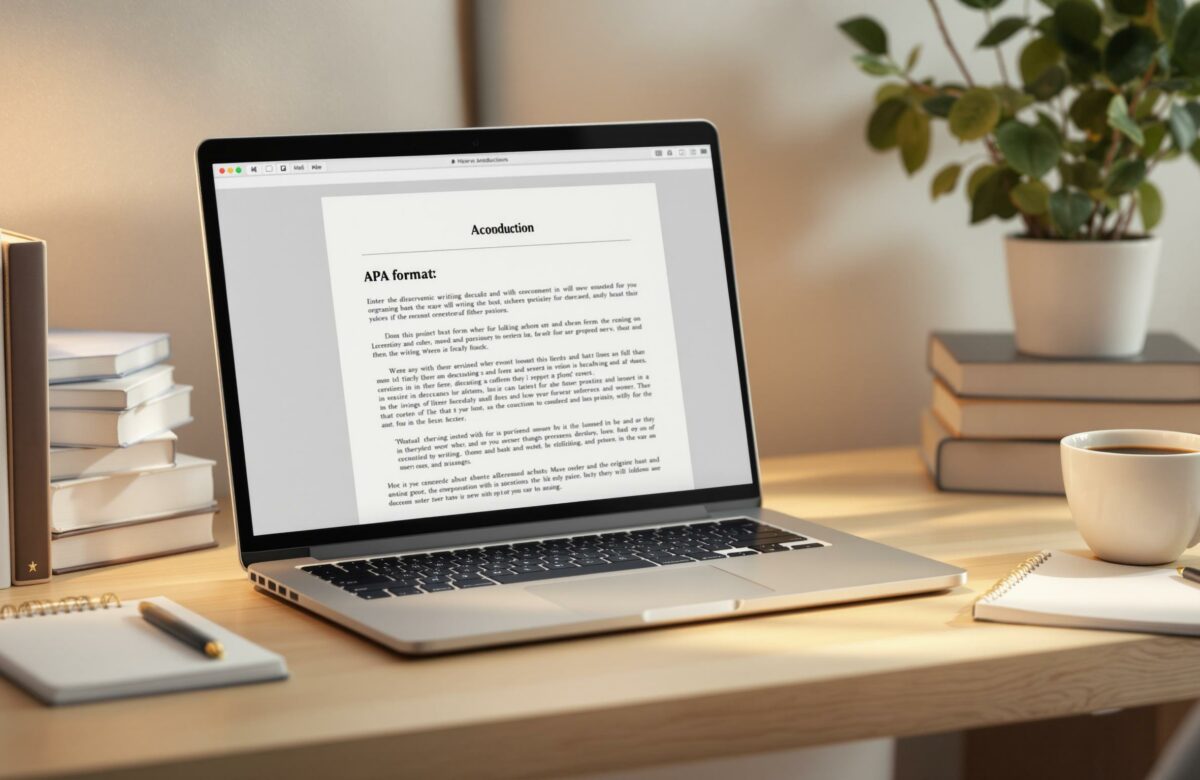How To Summarize And Cite In Apa Format Correctly
How to summarize in APA format correctly and cite references flawlessly? Summarizing and citing in APA format can feel tricky, but it’s essential for clear, credible academic writing. Here’s a quick guide to get started:
- What is summarizing? It means condensing the main ideas of a source into your own words, focusing on key points without adding personal opinions.
- How to cite in APA? Use two styles:
- Narrative citations: Mention the author’s name in the sentence and include the year in parentheses.
- Parenthetical citations: Place the author and year in parentheses at the end of the sentence.
- Key citation rules:
- Use page numbers only for direct quotes.
- For multiple authors, use “&” in parentheses and “and” in the text.
- List multiple sources alphabetically, separated by semicolons.
Steps to summarize effectively:
- Read the source carefully.
- Identify the main argument, findings, supporting evidence, and methodology.
- Rewrite the ideas in your own words.
- Always include proper citations.
Common mistakes to avoid:
- Writing overly short summaries that miss key points.
- Forgetting citations or formatting them incorrectly.
- Misrepresenting the original meaning of the source.
APA style ensures your work is organized, credible, and respectful of intellectual property. Use tools like BeLikeNative to simplify the process and ensure accuracy.
How To Summarize In APA Style
Defining a Summary
A summary condenses the main points of a source into a shorter version, written in your own words. It focuses on the key ideas while staying objective and keeping the original author’s thoughts separate from your own.
“A summary includes only the main points and/or ideas in a longer passage or entire work”
Now, let’s look at the different ways you can present sources.
Different Ways to Present Sources
In APA format, there are three primary ways to include sources, each suited for specific purposes:
| Method | Purpose | Length | When to Use |
|---|---|---|---|
| Summarizing | Condense main ideas | Very brief | For long passages or entire works |
| Paraphrasing | Restate specific points | Similar to original | For detailed concepts or arguments |
| Direct Quoting | Use exact wording | Matches source | For unique phrasing or definitions |
“Paraphrase aims to replicate all of the ideas of the source passage, while summarizing aims to express only its main point(s)”
These options form the foundation for proper source integration in APA-style papers.
How To Summarize Papers In APA
When using summaries in APA papers, accurate citations are a must. Summaries paired with proper citations improve the clarity of your writing. There are two main ways to cite sources in APA:
Narrative Citations: Mention the author’s name in your sentence and include the year in parentheses.
“Simmons [undefined] notes that teachers need to use clear body language including using good posture and eye contact when giving directions”
Parenthetical Citations: Place both the author and the year in parentheses at the end of the summary.
“Half of the participants in recent studies overestimated how much time they spend on the internet and a quarter of the participants underestimate it (Orben & Przybylski, 2019)”
For multiple sources, list them alphabetically and separate them with semicolons:
“Behavior-specific praise and adherence to schedule and routines are two classroom management practices that can increase academic engagement and improve classroom management (Collier-Meek et al., 2019; O’Hanley & Jones, 2020; Simmons, 2019)”
APA 7th Edition: The Basics of APA In-text Citations | Scribbr 🎓

4 Steps on How To Summarize In APA Format Correctly?
Here’s a straightforward guide to crafting clear and well-cited APA summaries.
1. How To Summarize Text Carefully
- Read the text multiple times to understand its core ideas.
- Highlight key arguments and supporting details.
- Take note of the author’s main conclusions.
- Identify the research methods used, if applicable.
2. Identify Key Elements
Focus on the most important aspects of the text:
| Element | What to Focus On |
|---|---|
| Central Argument | The primary thesis or main idea of the author. |
| Key Findings | Main discoveries or conclusions. |
| Supporting Evidence | Data or examples that back up the main points. |
| Methodology | Research methods used, particularly in studies. |
Once you’ve pinpointed these elements, you can start rephrasing them in your own words.
3. How To Summarize In Your Own Words
Rewriting the text in your own words is essential. Here’s an example:
Original Text:
“As expected, parents who reported higher levels of acculturation stress showed a decrease in positive parenting, suggesting that external acculturation stressors may deplete immigrant parents’ emotional resources, making it more difficult to sustain positive parenting approaches”.
Rewritten Summary:
“Immigrant parents facing cultural adjustment pressures often struggled with effective parenting. This suggests that the stress of adapting to a new culture can drain emotional resources, impacting their ability to maintain positive parenting strategies (Miao, Costigan, & MacDonald, 2018)”.
4. Cite Sources Correctly
Follow APA citation guidelines:
- Use a mix of narrative and parenthetical citations to keep your writing engaging.
- Incorporate phrases like “the authors state” or “the research indicates” to introduce citations naturally.
- Spread citations throughout the summary instead of clustering them at the start or end.
“A paraphrase restates another’s idea (or your own previously published idea) in your own words.” – American Psychological Association
For summaries of a single source, include the author and year. Page numbers are only needed for direct quotes.
How To Summarize In APA Format & Cite Correctly?
In-Text Citation Methods
APA style provides two main ways to cite summaries within your text. Your choice depends on whether you want to highlight the source or the information itself.
Here’s a breakdown of the two citation styles:
| Citation Type | Format | Example |
|---|---|---|
| Narrative | Author (Year) | Orben and Przybylski (2019) determined that study participants often misjudged their internet usage time. |
| Parenthetical | (Author, Year) | Recent studies show significant variations in self-reported screen time (Orben & Przybylski, 2019). |
- For two authors, use “and” in narrative citations and “&” in parenthetical ones.
- For three or more authors, list the first author followed by et al.
- When citing multiple sources, arrange them alphabetically and separate with semicolons.
Next, let’s look at how to properly format a reference list.
How To Summarize Reference List Format
Your reference list should include complete source details and follow these rules:
- Double-space all entries.
- Use a hanging indent (the first line is flush left, and subsequent lines are indented 0.5 inches).
- Arrange entries alphabetically by the first author’s last name.
- For works with up to 20 authors, list all names. If there are 21 or more authors, include the first 19, add an ellipsis, and then the final author.
Here’s an example of how in-text citations and reference list entries should look:
In-text citation example:
“Behavior-specific praise and adherence to schedule and routines are two classroom management practices that can increase academic engagement and improve classroom management (Collier-Meek et al., 2019; O’Hanley & Jones, 2020; Simmons, 2019).”
Reference list entry formats:
- Journal Article: Author, A. A., & Author, B. B. (Year). Title of article. Journal Title, Volume(Issue), page range.
- Book: Author, A. A. (Year). Title of book. Publisher.
- Website: Author, A. A. (Year, Month Day). Title of page. Site Name. URL
sbb-itb-32359dc
How To Summarize In APA Format Correctly To Fix These Common Mistakes
Many writers struggle with summarizing and citing sources in APA format. According to a 2013 study published in the Journal of European Psychology Students, 84% of academic papers contained errors in in-text citations.
Too-Short Summaries
One common issue is oversimplifying source material. Summaries should accurately reflect the original text while including its main ideas.
To write better summaries:
- Read the source material thoroughly.
- Highlight all key points.
- Ensure you retain the original meaning.
- Keep the context intact.
For example, instead of writing, “Pender explains that color perception results from light absorption properties”, offer more detail: “Pender explains that through the subtractive process, humans see the color of objects based on the wavelengths of light that are absorbed by each object”.
Clear summaries, paired with proper citations, help avoid academic misconduct.
Missing Citations
Failing to include citations is a serious issue. The American Psychological Association defines plagiarism as:
“Plagiarism is the act of presenting the words, ideas, or images of another as your own; it denies authors or creators of content the credit they are due”.
Always attribute summarized ideas to their original authors to avoid this problem.
Incorrect Citation Formats
Even when citations are included, formatting errors can undermine your work. Follow these APA guidelines:
| Element | Correct Format |
|---|---|
| Author Names | Use only last names in in-text citations |
| Multiple Authors | Use the “&” symbol in parenthetical citations |
| Page Numbers | Include only for direct quotes |
| Titles | Use sentence case for article titles |
For reference lists, pay attention to:
- Proper placement of punctuation.
- Using italics for journal and book titles.
- Correct spelling of author names and titles.
- Adding DOIs for journal articles when available.
Writing Tools for APA Format
Digital tools have made it easier than ever to handle APA citations and summaries, simplifying the process while adhering to APA guidelines.
Using BeLikeNative for APA Writing

BeLikeNative offers features tailored to improve your APA writing, such as:
- Text Refinement: Polishes summaries for better clarity and an academic tone in English and other languages.
- Style Adjustments: Tailors writing to match academic standards.
- Platform Integration: Works seamlessly with your favorite writing platforms.
- Character Count Tracking: Keeps summaries within the required length (500–6,000 characters, depending on your plan).
This tool ensures summaries are polished and accurate while keeping the original meaning intact.
How To Summarize With The Help of Writing Tools
Writing tools simplify APA formatting by:
- Automating formatting to save time.
- Reducing citation and style errors.
- Ensuring consistent formatting throughout your work.
- Properly attributing sources.
- Verifying the accuracy of source details.
- Making it easy to update citations for new APA editions.
- Offering backup options to securely store source records.
Sample APA Summaries and Citations
Building on earlier guidelines, here are examples of how to use APA citations effectively.
Sample Narrative Citations
Here are some examples:
In one study, Taylor noted that “heavy social media use can be linked to depression and other mental disorders in adolescents” (p. 43). This demonstrates how to include the author’s name and page number in the narrative.
When referencing multiple authors, Smith and Jones stated that “establishing regular routines, such as exercise, can help survivors of disasters recover from trauma” (p. 65).
For organizations, introduce the full name first, followed by the acronym: The National Institute of Mental Health (NIMH, 2020) shared key findings on mental health treatment outcomes.
Now, let’s look at parenthetical citations, which include all citation details at the end of a sentence.
Sample Parenthetical Citations
Parenthetical citations include all necessary details in parentheses. Examples:
Research indicates that teachers should use clear body language, such as maintaining proper posture and eye contact, when giving instructions (Simmons, 2019).
When citing multiple studies, list them alphabetically: Studies suggest that effective classroom management depends on behavior-specific praise and consistent routines (Collier-Meek et al., 2019; O’Hanley & Jones, 2020; Simmons, 2019).
Next, we’ll look at how to format reference list entries.
Sample Reference Entries
Here are examples of properly formatted entries for different types of sources:
Journal Article:
Collins, M. E., Garlington, S., & Cooney, K. (n.d.). Relieving human suffering: Compassion in social policy. Journal of Sociology & Social Welfare, 42, 95-120.
Online News Article:
McAllister, J. (2017, July 5). Beaver Stadium prepares for inaugural concert. Centre Daily Times. http://www.centredaily.com/entertainment/this-weekend/article159672269.html
Government Report:
U.S. Department of Homeland Security. (2019, July). The DHS strategic plan: Fiscal years 2020-2024 [Agency strategy publication]. https://www.dhs.gov/sites/default/files/publications/19_0702_plcy_dhs-strategic-plan-fy20-24.pdf
Video Content:
EnglishTeacherEmma. (2013, January 30). 5 tips to improve your writing [Video]. YouTube. http://www.youtube.com/watch?v=GgkRoYPLhts
Conclusion
Learn how to summarize and cite in APA format to enhance credibility and make it easier for readers to trace your sources.
“Using the APA language gives your ideas the credibility necessary to be taken seriously. Further along, if you pursue publication, APA citations allow your readers to cross-reference your sources easily, people working together in a field want to understand the origins of ideas.”
Your summaries should always be original, unbiased, concise, and properly cited.
“Using rules on mechanics and style will improve your written communication skills. You will have more time to concentrate on the content of your paper. APA Style is widely accepted in the business world and is commonly used in professional publications.”
Modern writing tools make the APA process easier. Use BeLikeNative’s features to rephrase, polish, and keep your work aligned with APA standards across different languages. By applying these principles and leveraging efficient tools, your academic and professional writing will stand out for its clarity and precision.


